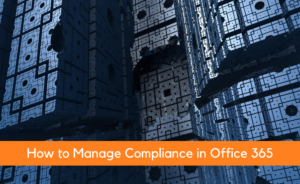How to Manage Compliance in Office 365
Is your organization appropriately managing compliance? Office 365 has a number of tools that are designed to aid with legal and regulatory compliance requirements, including SOX, HIPPA, and PCI, but they may not cover enough. Any transition to Office 365 should be planned with compliance management in mind and create a seamless compliance foundation for on-premises, hybrid, and cloud. Compliance management in Office 365 begins with an understanding of the different compliance standards and regulations that presently guide the handling of critical information assets, alongside the implementation of Office 365’s unique security and access features. Compliance management in Office 365 differs based on whether an Office 365 cloud solution is used or a hybrid solution between on-premise and cloud-based systems.Microsoft Provided Tools for Managing Compliance
As a complete communication, collaboration, and productivity center, Office 365 and the Microsoft Cloud comes with a number of cloud features designed to meet compliance needs and enhance security.- Data Loss Prevention(DLP). DLP is comprised of both strategy and admin center tools, focused on controlling the flow of sensitive information outside of the corporate network, and the ability to secure this data against potential loss. OneDrive for Business and the Microsoft Cloud are both able to secure data against loss while also securing it against intrusion.
- eDiscovery Center. Businesses occasionally need to enter into the process of discovery: searching for, locating, and retrieving records for the purposes of legal action. The eDiscovery center makes it possible for a 365 admin to swiftly find documents through Microsoft 365: all documents within the system are discoverable and can be organized by using the appropriate settings.
- Continuous Compliance Services. Microsoft’s compliance manager and security and compliance center includes over 1,000 controls, intended to govern data-handling policies and procedures, and automate many of the more important compliance and security standards. Administrators can rely upon security controls rather than having to manually introduce each individual compliance rule.
Improved Compliance with Third-Party Tools
Office 365 has several built-in tools that can make this process easier, but it isn’t always a complete solution. When integrating third-party tools into the Microsoft ecosystem, organizations may need to augment their compliance management in Office 365 with additional systems. While Office 365 will secure internal solutions such as SharePoint Online and Exchange Online, securing third-party solutions often requires additional data management and access control. Hybrid customers must manage compliance across both on-premise and cloud-based solutions, and due to the increased complexity of their network and the Microsoft ecosystem, additional steps often need to be taken to manage compliance. Common issues regarding compliance management in Office 365 and hybrid networks include:- User Provisioning and de-provisioning users. New accounts must be continually created and kept accurate and eventually deprovisioned. Because this must happen between on-premises and Office 365 in Hybrid environments — making the process more complex.
- Approval over group membership changes. Data can easily be compromised if group memberships are not controlled, as organizations may swiftly lose control over user access or user permissions.
- Group attestation/certification reviews by the data owner. Regularly reviewing who has access to compliance sensitive data to support regulatory standards is necessary to prevent compliance failures which may result in heavy fines or even jail for company officers.
- Enterprise reporting. Information must be available throughout third-party solutions, on-premise solutions, and cloud-based solutions regarding the flow of data and how the data is being protected.
